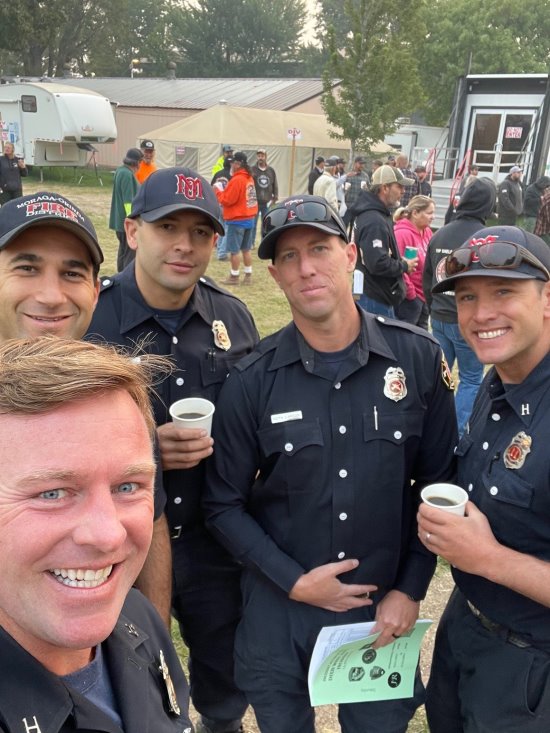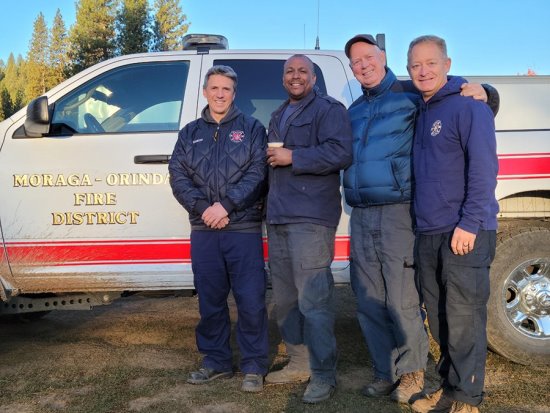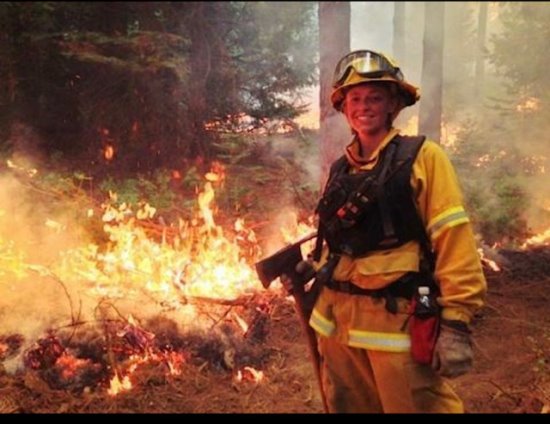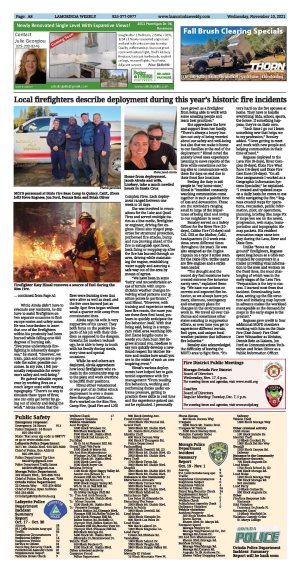| | Published November 10th, 2021
| Local firefighters describe deployment during this year's historic fire incidents
| | | By Vera Kochan |  | | Quincy's Dixie Fire Base Camp, from left: Jacob Airola, Dan Elbanna, Travis Dulli, Keith Larson and Jon Bensley Photo Jacob Airola |
The firefighters with the Moraga-Orinda Fire District and the Contra Costa County Fire Protection District are not only charged with keeping Lamorinda safe, they choose to volunteer in other jurisdictions when blazes become out of control for local fire companies, like the historic Caldor and Dixie fires.
 Moraga Station 42 Captain/Paramedic Jacob Airola and Firefighter/Paramedic Katy Himsl, along with Orinda Station 43 Captain/Paramedic Jon Bensley and Engineer/Emergency Medical Technician Steve Rogness are just some of MOFD's personnel who volunteered for deployment to the season's most terrifying fires.
Moraga Station 42 Captain/Paramedic Jacob Airola and Firefighter/Paramedic Katy Himsl, along with Orinda Station 43 Captain/Paramedic Jon Bensley and Engineer/Emergency Medical Technician Steve Rogness are just some of MOFD's personnel who volunteered for deployment to the season's most terrifying fires.
 This year, Airola responded to three incidents in the capacity of Safety Officer, spending 16 days in August at the Dixie Fire and 16 days between late September and early October during the Caldor Fire. He also assisted the Governor's Office of Emergency Services with COVID-19 prevention and outbreaks within the State Operations Center for eight days in June.
This year, Airola responded to three incidents in the capacity of Safety Officer, spending 16 days in August at the Dixie Fire and 16 days between late September and early October during the Caldor Fire. He also assisted the Governor's Office of Emergency Services with COVID-19 prevention and outbreaks within the State Operations Center for eight days in June.
 "A (Line) Safety Officer primarily focuses on preventing injuries to those working at the incident," explained Airola. "These include interventions such as traffic control measures, identifying/creating escape routes and safety zones, and writing incident reports to prevent future injury/accidents from occurring."
"A (Line) Safety Officer primarily focuses on preventing injuries to those working at the incident," explained Airola. "These include interventions such as traffic control measures, identifying/creating escape routes and safety zones, and writing incident reports to prevent future injury/accidents from occurring."
 While Airola didn't have to evacuate any residents, he did have to assist firefighters on two separate occasions to find escape routes and safety zones. He was heartbroken to learn that one of the firefighters within his proximity had been burned while falling onto 600 degrees of burning ash. "Everyone understands firefighting is inherently dangerous," he stated. "However, we train, plan and operate to provide the safest possible outcomes. In my role, I felt personally responsible for everyone's safety and well-being."
While Airola didn't have to evacuate any residents, he did have to assist firefighters on two separate occasions to find escape routes and safety zones. He was heartbroken to learn that one of the firefighters within his proximity had been burned while falling onto 600 degrees of burning ash. "Everyone understands firefighting is inherently dangerous," he stated. "However, we train, plan and operate to provide the safest possible outcomes. In my role, I felt personally responsible for everyone's safety and well-being."
 He gained valuable experience by working fires on a much larger scale with varying topography. "There's no way to simulate these types of fires; one can only get better by going out of county and doing the work." Airola noted that the fires were burning trees that were alive as well as dead, and the live ones burned just as easily. Spot fires began without wind a quarter mile away from containment lines.
He gained valuable experience by working fires on a much larger scale with varying topography. "There's no way to simulate these types of fires; one can only get better by going out of county and doing the work." Airola noted that the fires were burning trees that were alive as well as dead, and the live ones burned just as easily. Spot fires began without wind a quarter mile away from containment lines.
 Airola says his wife is very supportive of his career. They both focus on the positive impacts of his job with their children as opposed to the dangers. Grateful for modern technology, he is able to keep in touch with his family during meals, story time and special occasions.
Airola says his wife is very supportive of his career. They both focus on the positive impacts of his job with their children as opposed to the dangers. Grateful for modern technology, he is able to keep in touch with his family during meals, story time and special occasions.
 While he and others are deployed, Airola appreciates how local firefighters who remain in the community step up to the plate and work overtime to backfill their positions.
While he and others are deployed, Airola appreciates how local firefighters who remain in the community step up to the plate and work overtime to backfill their positions.
 Himsl either volunteered or was part of an Initial Attack deployment to over a dozen fires throughout California. She's worked on the Rim Fire, Camp Fire, Quail Fire and LNU Complex Fires. Each deployment ranged between one week to 16 days.
Himsl either volunteered or was part of an Initial Attack deployment to over a dozen fires throughout California. She's worked on the Rim Fire, Camp Fire, Quail Fire and LNU Complex Fires. Each deployment ranged between one week to 16 days.
 She was involved in evacuations for the Lake and Quail Fires and served multiple duties as a line medic, firefighter or engineer, driving fire engines. Himsl also triaged properties for structural protection, performed fire attacks, bump and run (moving ahead of the fire to extinguish spot fires), back firing or mopping up after the fire has burned through an area, driving while maintaining the engine, establishing water supply and assuring a safe way out of the area by means of egress.
She was involved in evacuations for the Lake and Quail Fires and served multiple duties as a line medic, firefighter or engineer, driving fire engines. Himsl also triaged properties for structural protection, performed fire attacks, bump and run (moving ahead of the fire to extinguish spot fires), back firing or mopping up after the fire has burned through an area, driving while maintaining the engine, establishing water supply and assuring a safe way out of the area by means of egress.
 "We have been in some `hairy' and uncomfortable areas of terrain with unpredictable weather changes involving wind patterns and ignition points in particular," said Himsl. "However, with training and experience seeing how fire reacts, the more you see these fires first hand, you learn to quickly anticipate the fire behavior itself. With that being said, being in a temporary relief area watching 200-foot flame lengths come towards you then burn 360 degrees around you, needless to say you quickly develop a newfound respect for Mother Nature and realize how small you are in the midst of such an awe inspiring event."
"We have been in some `hairy' and uncomfortable areas of terrain with unpredictable weather changes involving wind patterns and ignition points in particular," said Himsl. "However, with training and experience seeing how fire reacts, the more you see these fires first hand, you learn to quickly anticipate the fire behavior itself. With that being said, being in a temporary relief area watching 200-foot flame lengths come towards you then burn 360 degrees around you, needless to say you quickly develop a newfound respect for Mother Nature and realize how small you are in the midst of such an awe inspiring event."
 Himsl's various deployments have helped her to gain untold experience with fire management: "From reading fire behaviors, working and performing duties under extreme pressure, getting to practice these skills in real time and the experience gained can not be replicated. I personally have grown as a firefighter from being able to work with some amazing people and learn best practices."
Himsl's various deployments have helped her to gain untold experience with fire management: "From reading fire behaviors, working and performing duties under extreme pressure, getting to practice these skills in real time and the experience gained can not be replicated. I personally have grown as a firefighter from being able to work with some amazing people and learn best practices."
 She appreciates the love and support from her family. "There's always a heavy burden not only of being worried about our safety and well-being but also that we make it home to our families at the end of the deployment." Himsl noted the anxiety loved ones experience listening to news reports of the fires while sometimes not being able to communicate with them for days on end due to their front line locations.
She appreciates the love and support from her family. "There's always a heavy burden not only of being worried about our safety and well-being but also that we make it home to our families at the end of the deployment." Himsl noted the anxiety loved ones experience listening to news reports of the fires while sometimes not being able to communicate with them for days on end due to their front line locations.
 Feeling the duty to aid people in "my home state," Himsl is "humbled constantly watching communities come together in such a painful time of loss and devastation. These are the reminders ranging small to large of the importance of being kind and loving to our neighbors in need."
Feeling the duty to aid people in "my home state," Himsl is "humbled constantly watching communities come together in such a painful time of loss and devastation. These are the reminders ranging small to large of the importance of being kind and loving to our neighbors in need."
 Bensley served as a Safety Officer for the River Fire (10-days), Caldor Fire (15-days) and CAL OES at the Mather, Calif., headquarters (1-2 week rotations, seven different times throughout the year). He was also assigned as the Engine Captain on a type 3 strike team for the Dixie Fire. Strike teams are five engines and a strike team leader.
Bensley served as a Safety Officer for the River Fire (10-days), Caldor Fire (15-days) and CAL OES at the Mather, Calif., headquarters (1-2 week rotations, seven different times throughout the year). He was also assigned as the Engine Captain on a type 3 strike team for the Dixie Fire. Strike teams are five engines and a strike team leader.
 "The drought and the record dry fuel moistures have created extreme fire behavior rarely seen," explained Bensley. "We base our actions on current and expected fire behavior, so we always have primary, alternate, contingency and emergency plans for changes in the environment we work in. We travel all over California and sometimes other states assisting in suppression efforts, so over time you get to experience different terrain, fuel types, and unique local weather patterns that influence fire behavior."
"The drought and the record dry fuel moistures have created extreme fire behavior rarely seen," explained Bensley. "We base our actions on current and expected fire behavior, so we always have primary, alternate, contingency and emergency plans for changes in the environment we work in. We travel all over California and sometimes other states assisting in suppression efforts, so over time you get to experience different terrain, fuel types, and unique local weather patterns that influence fire behavior."
 Bensley also acknowledged the difficulty of leaving the MOFD area to fight fires. "It's very hard on the fire spouses at home. They have to handle everything: kids, school, sports, the house. If something happens, they're on their own.
Bensley also acknowledged the difficulty of leaving the MOFD area to fight fires. "It's very hard on the fire spouses at home. They have to handle everything: kids, school, sports, the house. If something happens, they're on their own.
 "Each time I go out I learn something new that helps me in my profession," Bensley added. "I love getting to meet and work with new people and helping communities in their time of need."
"Each time I go out I learn something new that helps me in my profession," Bensley added. "I love getting to meet and work with new people and helping communities in their time of need."
 Rogness deployed to the Lava Fire (8-days), River Complex (8-days), Dixie Fire West Zone (16-days) and Dixie Fire East Zone (16-days). "On all four assignments I worked as a Geographic Information Systems Specialist," he explained. "I created and updated maps on a daily basis for crews to use while navigating the fire." Rogness created maps for operations, evacuation, public information, pilot, air operations, planning, briefing (the large 6'x 8' maps you see on the news), progression, web maps, transportation and topographic tile map packets. His resident evacuation maps came into play during the Lava, River and Dixie fires.
Rogness deployed to the Lava Fire (8-days), River Complex (8-days), Dixie Fire West Zone (16-days) and Dixie Fire East Zone (16-days). "On all four assignments I worked as a Geographic Information Systems Specialist," he explained. "I created and updated maps on a daily basis for crews to use while navigating the fire." Rogness created maps for operations, evacuation, public information, pilot, air operations, planning, briefing (the large 6'x 8' maps you see on the news), progression, web maps, transportation and topographic tile map packets. His resident evacuation maps came into play during the Lava, River and Dixie fires.
 Unlike "boots on the ground" firefighters, Rogness spent long hours as a GISS surrounded by computers in a trailer providing vital information to the men and women on the front lines, the most challenging of which was in the early stages of the Lava Fire. "Preparation is the key to success. I learned most from that incident. Downloading base data, setting up the file structure and initiating map layouts in advance makes the workload manageable as the demand for maps in the early stages is the greatest."
Unlike "boots on the ground" firefighters, Rogness spent long hours as a GISS surrounded by computers in a trailer providing vital information to the men and women on the front lines, the most challenging of which was in the early stages of the Lava Fire. "Preparation is the key to success. I learned most from that incident. Downloading base data, setting up the file structure and initiating map layouts in advance makes the workload manageable as the demand for maps in the early stages is the greatest."
 Rogness gave credit to four additional MOFD members working with him on the Dixie Fire (East Zone): Fire Chief Dave Winnacker as Division, Dennis Rein as Liaison, Jon Ford as Communications Technician and Brian Oliver as a Public Information Officer.
Rogness gave credit to four additional MOFD members working with him on the Dixie Fire (East Zone): Fire Chief Dave Winnacker as Division, Dennis Rein as Liaison, Jon Ford as Communications Technician and Brian Oliver as a Public Information Officer. |
 | | Working as Engineer during LNU Complex, firefighter Katy Himsl drives through a flaming landscape. Photo provided |  | | MOFD personnel at Dixie Fire Base Camp in Quincy, Calif., (from left) Steve Rogness, Jon Ford, Dennis Rein and Brian Oliver Photo provided |  | | Firefighter Katy Himsl removes a source of fuel during the Rim Fire. Photo provided |  | | Home from deployment, Jacob Airola and wife, Lindsey, take a much needed break in Santa Cruz Photo Jacob Airola |  | | story-photo-caption6 | | | |









